by Tom Gaylord, a.k.a. B.B. Pelletier
If you’ve reached this webpage because you’re searching for information about the AirForce Talon SS rifle in .22 caliber, please note, this report is not about a standard rifle. You may be more interested in the 10-part Talon SS test than in this one.
For those who are following this series, this is the first accuracy test. Today, I’ll test the barrel made by Dennis Quackenbush with a twist rate of 1:12 inches. I’m testing with two pellets at this time — the 14.3-grain Crosman Premier and the 15.9-grain JSB Exact. You’ll soon see why I’ve chosen to test with just two pellets, as there are several variables that each required testing. I’m trying to limit the number of shots in each test.
Following today’s test, I’ll do the same thing with the factory barrel and also with the other barrel Quackenbush made with a 1:22 inch twist rate. Then, I’ll write a report that analyzes the data from the three accuracy tests. After that, I plan to shoot each barrel at 50 yards for accuracy, but that will probably be done on power setting 10, alone, unless there are compelling reasons to do otherwise.
The test
I shot the rifle at two distances — 10 meters (11 yards) and 25 yards. Each pellet was tested on each power level — zero, 6 and 10. If you forget how those levels are controlled, you can find them described and shown in Part 2. The standard was a 10-shot group. Because the Talon SS is so easy to shoot (it requires no special holding technique), I went with just one group. There’s always the possibility of returning and shooting additional groups after everything has been tested; but as we’ve learned from reading this blog, a 10-shot group is very representative of the true accuracy of a rifle.
There were no called fliers in this test. While that sounds incredible for 120 aimed shots (yes, 120 shots!), I was resting the rifle in the groove of a large sandbag while shooting and it was extremely stable. I did note on one test of the rifle at zero power immediately after filling the reservoir that the pellets were stringing wildly (about 6 inches) in the vertical dimension. I threw that test out and shot another group with the same pellet after the reservoir pressure had dropped a bit. That one seemed reasonable.
I shot 20 shots on zero power (10 with each pellet) and 20 shots on power level 6. The reservoir was refilled before I shot 20 shots on power setting 10 with both pellets. I did this at 10 meters and again at 25 yards. I have some things I want to say about this test. Before I do, let’s look at the results.
Ten-meter testing
At 10 meters, the first test was with both pellets on power setting zero. Before I tested the gun, the rifle was zeroed so the pellets would land close to or inside the bull I was aiming at, but not hitting the center — as that was the aim point for every shot. As always, it’s the group size I’m concerned about — not where the pellets land.
Zero power
Premiers made a 10-shot group that measured 0.509 inches between centers. Though the group is large for a Talon SS, in my experience, it’s fairly well distributed. So, the barrel made by Quackenbush seems to be accurate enough for this test. We know from the velocity test that Premiers average 452 f.p.s. in the 1:12 barrel and the velocity spread is 56 f.p.s.
Ten JSB Exacts made a group that measures 0.578 inches between centers. That’s just a little larger than the Premier group. It’s also a bit more horizontal than vertical. We know from velocity testing that this pellet averages 434 f.p.s. in the 1:12 barrel, with a spread of 56 f.p.s.
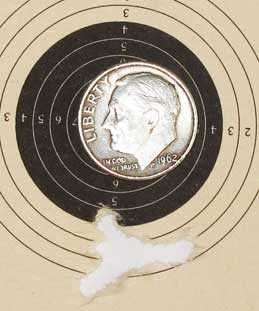
On zero power, 10 Premiers made a 0.509-inch group at 10 meters in the 1:12 barrel.
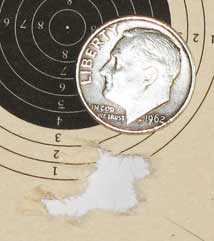
On zero power, 10 JSBs made a 0.578-inch group at 10 meters in the 1:12 barrel.
Power setting 6
Moving up to power level 6, I fired one shot to see where the pellet was going and to allow the valve to adjust to the new setting. Ten Premier pellets made a group measuring 0.408 inches between centers. Velocity at this power setting averages 777 f.p.s. in the 1:12 barrel, with a spread of 63 f.p.s.
Ten JSB pellets made a group that measured 0.419 inches between centers. It was really too close to the other group (of Premiers) to make a distinction; but when I measured it, that’s what I got. The average velocity on this setting with the JSB pellet is an average 786 f.p.s., with a 41 f.p.s. spread.
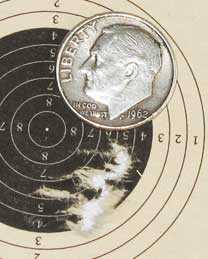
On power setting 6, 10 Premiers made a 0.408-inch group at 10 meters in the 1:12 barrel.
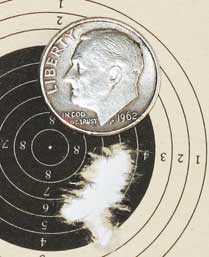
On power setting 6, 10 JSBs made a 0.419-inch group at 10 meters in the 1:12 barrel.
Power setting 10
Moving up to power setting 10, I fired one shot to set the valve. Then, 10 Premiers made a 0.281-inch group. The velocity at this power setting averages 846 f.p.s., with a spread of 16 f.p.s.
Ten JSB pellets made a group that measured 0.286 inches between centers. Once again, the difference between the JSBs and Premiers was really too close to call. At this power setting, the velocity averages 830 f.p.s., with a spread of 15 f.p.s.
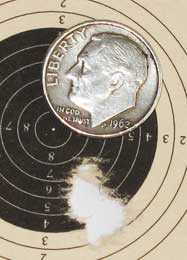
On power setting 10, 10 Premiers made a 0.281-inch group at 10 meters in the 1:12 barrel.
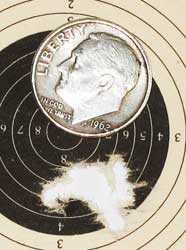
On power setting 10, 10 JSBs made a 0.286-inch group at 10 meters in the 1:12 barrel.
That concludes testing at 10 meters. Now, it’s time to pull back to 25 yards and try everything all over.
Twenty-five-yard testing
Starting at zero power, this was where I discovered that I had to throw out the first group for extreme vertical stringing. After that, though, the gun calmed down and seemed to group as well as it could.
Zero power
On zero power at 25 yards, Premiers made a 10-shot group that measured 0.903 inches between centers. This is a larger group than I’m used to with an SS, but it seems to be more due to the valve and the velocity variation than the barrel. You’ll notice that there’s a smaller group of 6 shots at the bottom of this group. They were not fired sequentially, though.
Ten JSB Exacts made a group that measures 1.142 inches between centers. Again, there was a smaller group within the large group, but it contains fewer shots than the small group within the Premier target.
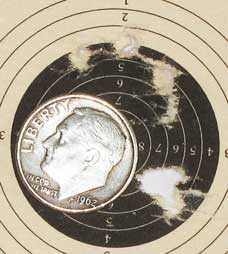
On zero power, 10 Premiers made a 0.903-inch group at 25 yards in the 1:12 barrel.
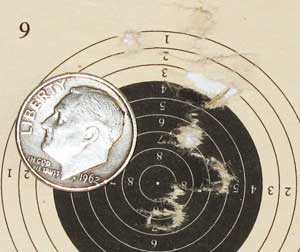
On zero power, 10 JSBs made a 1.142-inch group at 25 yards in the 1:12 barrel.
Power setting 6
Moving up to power level 6, I fired one shot to see where the pellet was going, plus to allow the valve to adjust to the new setting. Ten Premier pellets made a group measuring 0.375 inches between centers. Velocity at this power setting averages 777 f.p.s. in the 1:12 barrel, with a spread of 63 f.p.s.
Ten JSB pellets made a group that measured 0.979 inches between centers. The average velocity on this setting with the JSB pellet is 786 f.p.s., with a 41 f.p.s. spread. That’s quite a difference from the Premier group at the same power setting/same distance.
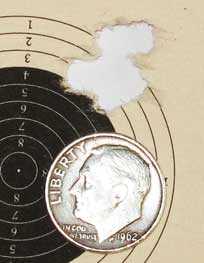
On power setting 6, 10 Premiers made a 0.375-inch group at 25 yards in the 1:12 barrel.
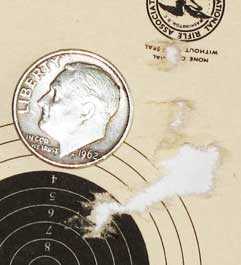
On power setting 6, 10 JSBs made a 0.979-inch group at 25 yards in the 1:12 barrel.
Power setting 10
Moving up to power setting 10, I fired one shot to set the valve. Then, 10 Premiers made a 0.753-inch group. It’s still a fairly well-rounded group.
Ten JSB pellets made a group that measured 0.944 inches between centers on power setting 10. This time, the group was not just larger, there were several pellets that did not land in the same place. It’s also strung out horizontally.
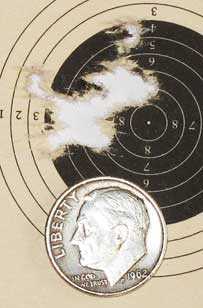
On power setting 10, 10 Premiers made a 0.753-inch group at 25 yards in the 1:12 barrel.
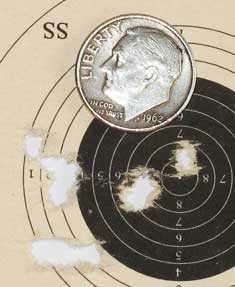
On power setting 10, 10 JSBs made a 0.944-inch group at 25 yards in the 1:12 barrel.
What did we learn?
This is just the first test of 3 barrels, so it’s too early to draw a lot of conclusions. But there are things that can be said about this one test. For starters, JSB Exact pellets seem to spread out at the longer distances and higher power levels. Are they over-stabilizing? Too soon to tell, but the Premiers definitely out-grouped them. That may change when we test the factory barrel.
Premiers really only opened up at 25 yards on power setting 10. And they didn’t group well at 10 meters on zero power. Everything else was okay. Are they a more stable pellet? In the 1:12 twist barrel, they seem to be.
In researching this report, I’ve read in several places where gun writers say there is no problem with over-stabilization from fast twist rates. They say that as long as the bullet is stable, there’s no difference in accuracy, regardless of the twist rate. That may or may not be true for bullets (though I doubt that it is), but it certainly isn’t true for these two pellets! That much has been proven pretty clearly.
Beyond that, I don’t think I can say anything else. Next, I’ll test the factory barrel.
This test involves shooting 12 10-shot groups per barrel, so it’s very involved. That’s why I can’t do all three barrels at one time. I hope you understand that.

No disrespect intended but the reason I’ve been following this report is because of the baseline that was announced.
This test began with:
“Test objective 1
The first test objective is to determine the effect of a different rifling twist rate on the accuracy of various pellets at various velocities with barrels of different twist rates. All three barrels will be considered, but we’re really interested in the results of the two barrels supplied by Quackenbush. I can’t say that the factory barrel will be used as a control because it’s made differently than the two barrels Dennis has made (different rifling method and it’s choked). But the data will be included in the test report simply because it exists and may be of interest at some point. Any poential accuracy differences will be noted.
I’ll conduct this test at 25 yards and again at 50 yards. That will tell us how the different twist rates perform at different distances.”
10 meters vs. 25 yards isn’t a viable test bed for this experiment in order to ascertain viable and justifiable conclusions.
Kevin,
If the reason for your state of agitation is that B.B. has not as of yet reported on the 50 yard accuracy test, fear not. Likely all three barrels will be tested at the same time at that range and will be in one report.
Being an accuracy nut myself, I too am chomping at the bit. By now you should know we will receive our coveted report, but others will be mixed in amongst the ones that we personally desire.
RR,
Yes, that is how I plan to do the 50-yard test. It may take a couple visits to the range if the wind doesn’t cooperate, but I do plan to report all three barrels together. Then I plan to do a summary report on all three barrels at all three distances and all three power levels with both pellets.
As I said, this test is involved.
B.B.
Kevin,
I AM shooting at 50 yards, I just added 10 meters as an extra. It’s in the report, but maybe I didn’t say it clearly enough.
B.B.
BB,
What do you mean you can’t test them all at the same time?!? And got in the 50 and even a 100 yard test astute same time??? Get off your backside and get to work, you lazy bum! Just kidding…. Seriously, 120 shots without a called flier? Now we know where superman hides!
Thanks for the report! I would have thought that the JSB’s would’ve made a better showing. But then again, you have great luck with the boxed CP’s, whereas every one of my guns thinks they’re mediocre at best if not downright hated…. I use them for pistol practice at 9 yards where I don’t see as much difference.
/Dave
/Dave,
I was very surprised by the poor showing the JSBs made. I think when I shoot the factory barrel that will turn around.
And the fact that Premiers shot so well was also a surprise.
B.B.
JSB Exacts are sold out of PA now, so they must doing something right. This is putting a serious crimp in my shooting. 🙁
Matt61
BB,
I enjoyed the AR article. I wouldn’t mind a whole series of those articles about what you have learned so far.
David Enoch
David,
As you notice, I labeled that Part 1. I do plan on a series on my AR, as I learn things about the rifle and how to load for it. I’m hoping for much better accuracy.
There are two things, however, that I want to keep in mind. First, this is a blog about airguns, so I have to do the firearms reporting very carefully. I think the firearms information is as pertinent as anything else, but I don’t want to turn off those who feel firearms are different than airguns.
Second, we are finding that the firearms articles I write are bringing in many new readers who are searching for some specific information about a firearm and stumble on this blog by accident. Some of them read the other reports and become fascinated by the state of adult airguns. That way we gain a new airgunner. So the firearms reports are very important. We just don’t want to do too many of them.
B.B.
You don’t have to be that careful about the firearms reports. I think they are fascinating. 🙂 I will want to hear more about the AR. By my interpolation, it looked like you were just outside of 1 MOA at 100 hundred yards with the less than ideal ammo.
Matt61
BB,
The AR article made me want to ask you what AR components you recommend but then reality hits me that I don’t have a place to shoot them and I hate the local gun ranges. Buying anymore firearms is something I need to put off until I have a place to shoot. Until then I have better things to do with my money.
I never thought about the firearm articles attracting others to airguns but it makes sense.
David Enoch
David,
If I’m not mistaken, I think Kevin came to us that way.
I would not be a good person to ask about ARs, because I know so little. We have readers on this blog, however, who know all about them.
I really value the small exclusive shooting club that I belong to. It’s like stepping back to the 1960s for me.
B.B.
Yep. Found my way here via firearm blogs.
I have a hunch that the real reason B.B. doesn’t want to write many blogs about firearms is because he fears another guy like me will appear on the blog!
kevin
Kevin,
Not so! I’ll take all the Kevins I can get. Send over a gross immediately. 😉
B.B.
Is that “gross” the classical 144 (12 dozen), or the more recent colloquialism for “grotesque” and “horrifying”?
BB,
I believe I already made this comment on the blog some time ago but when I shot my Talon that I bought from Mac at 30 yards and had the power setting on zero, the pellets slowed down enough that they weren’t penetrating the targets on my fibre board backer. In fact, I could actually watch the pellets home in on the target in the last couple of yards and bounce off. Zero power setting is fine for indoor 10 yard practice as far as I can see.
This study is very interesting. Which twist rate will produce the best results? I bet there are more than one manufacturer watching this blog.
Fred DPRoNJ
B.B., I continue to follow this research with interest. I was just thinking about your AR 15. You wrote, “…I confirmed that the rifle wants to be loaded single-shot with rounds that exceed the magazine length.”
I think Quigley would approve. ~Ken
The results you have so far are very unexpected as a matter of fact they are exactly the reverse of what I would have thought. The faster twist should have been able to stabilize the slower pellets and I would have expected the higher velocity would cause problems not so much because of over stabilization but because the soft lead pellets spinning at 51,000 RPM would tend to deform, which may be why the Premiers do better than the JSB’s.
I am curious if you have checked the barrel for leading since the test, just wondering if maybe some pellets are jumping the rifling.
I love it and hate it when a test goes this way, it challenges everything I thought I understood but it is a real opportunity to learn something new.
Do we know which of these two pellets is a softer lead? Thank you BB for putting in so much time on this one.
Steve B,
The JSB is definitely the softer lead, because the lead in the Premier is hardened.
B.B.
Hm, okay, I’ll be looking for the explanations of what we learn from all this from anyone who can keep numbers in their head or has a spreadsheet.
Wulfraed, you’re right. No crimp to the reloads. I didn’t think there was a need since I just use the gun at a target range and not a battlefield, but I’m keeping this in mind.
Mike, that is an unusual technique for a fighter to attack on a straight vertical underneath a bomber. I thought that the idea was to fly along the underside of the bomber. Yes, I had heard of that statistic about losing more airmen than the Marine Corps in WWII. Before fighter escort, that was a really slaughterhouse all taking place at -30 degrees. Miserable. And the air command responded by throwing more bombers into the conflagration. I can understand now why the bomber crews had parties that lasted for a week that would have made Animal House look like Sunday school.
I believe that the NY Safe Act specifically exempts both the M1 Garand and M1 Carbine. I also have a suspicion that one reason this law appears in NY is because of the proximity to the Sandy Hook incident coupled with the strongly anti-gun attitudes of the NYC mayor. I wonder if the rest of the states will follow suit. It seems that the Missouri legislature is trying to come up with a law that will override any federal legislation limiting guns. Where will this end?
Matt61
If you are single loading at the range, and were not doing multiple tweaks with the seating die, you were probably safe.
But if feeding from a magazine, you’ll want enough neck tension to keep the bullet from shifting under recoil. And I suspect repeating tweaks with a seating die is turning the bullet into the equivalent of the neck expander of a sizing die.
I’ll have to confess I’ve not reloaded bottle-neck cases… Only .30M1 Carbine and .357Mag (on a slow RCBS “Junior” [or whatever they called their small press in the late 70s]
Matt,
You want to know where this gun control issue will end? It will end in a fight and the government hopes that fight doesn’t happen until they have taken all our means of resistance (our guns for a start). The next step is to target any dissidents. The whole purpose of the second amendment is to give us a means to resist that government effort.
I can think of no other reason why the government’s reaction, including the federal and NY, to Sandy Hook wants to punish the entire nation for a senseless action that took place in an area that should have been protected the most by this so called government protection. Schools are government property yet they cannot protect their own property against these insane acts. So their reaction is to punish everyone, not just the guilty and insane.
-Chuckj
Obama and liberal Democrats were waiting for his second term and a “Incident” to push their gun control agenda. I don’t think the majority of Republicans and conservative Democrats will vote for it. That said, some parts of it may well pass. Time will tell.
You are correct, the second amendment isn’t about hunting.
Mike
Yes, that is a very, very unusual tactic to attack a bomber. I bet he shot down a number of bombers like that. Perhaps that is why he was out of cannon ammo. It would not be a tactic a bomber crew would be watching for. I can see how it might work but not that day.
Mike
You might find this of interest:
https://en.wikipedia.org/wiki/Erich_Hartmann#Fighting_technique
{tricky — having to remember a 70s paperback book title to find the name of the pilot to then find Wikipedia}
B.B.
Or anyone. Newby question. What does over-stabilizing mean?
john
John,
more spin on the bullet than necessary for stabilization.
In the worst case, bullets that are over-stabilized can explode in mid-flight or their cores can separate from their jackets, causing inaccurate flight.
B.B.
LOL… My prediction is that this is going to be BB’s first 100 part blog.
BB — I think you have the wrong data for the Premiers at 25 yards on Power level 6. I think you cut and pasted and forgot to change the data since it is the same as 10 yards. 0.408 inches.
Herb
Herb,
You’re right. I just corrected it. Thanks!
Edith
Thanks for double checking Edith!
There is a very interesting anomaly in the data.
“On power setting 6, 10 Premiers made a 0.408-inch group at 10 meters in the 1:12 barrel.”
“On power setting 6, 10 Premiers made a 0.375-inch group at 25 yards in the 1:12 barrel.”
Could just be statistics, but from the 10 yard data we’d expect that the 25 yard data would be about:
2.5*0.408 = 1.02 inches.
The group size at 25 yards certainly isn’t really smaller at 25 yards, but it would seem that 10 yards and 25 yards are much closer in size than they should be from geometry.
Herb,
I vaguely remember something like that happening with a c/f rifle with over-stabilized bullets — it got “less inaccurate” downrange. Perhaps something similar is happening even with the diabolo, as (according to my theory of where things go wrong) the trajectory is not steep enough at 25 yards for the drag induced attitude to be conflicting seriously with the spin induced one. I’m just sitting out the tests to see what happens; there’s bound to be more surprises.
Not really over-stabilized bullets. The factor is related to some sort of muzzle disturbance. The bullet “goes to sleep” in that a wobbling out of the muzzle decays. So at 100 yards the group size would be 1 inch and at 200 yards the group size would be 1.7 inches. So the group size still gets bigger with distance, just not as fast as geometry would predict.
I just thought this was really interesting since we are looking for weirdness in the pellet flight. Small sample statistics are against the experiments, but BB is open and honest about the testing that he is doing. Expecting him to shoot 10 groups at each power setting and distance would be way too much. 🙂
Herb,
I rechecked the groups, which I plan to keep a long time, sine this is the first of what I expect to be many tests.
Yes, the 25-yard group of Premiers does measure what I said. When I remeasured I got a slightly different number that was close enough to what was published to be correct.
The reason the 10-meter group looks smaller in the picture is a flap of paper has folded back over the hole. Look at the group closely and you can see the round tear through the number 4 at 7 o’clock that opens it up much larger. I should have pulled that flap back for the photo.
Sorry,
B.B,.
No reason to be sorry! I’m anxiously awaiting more. I don’t think I say it often enough, but I really enjoy your blog.
BB,
This is shaping up to be interesting. I’m not surprised to see “things” start to show up at 25 yards, but 50 will be the real test. I’m a little surprised by 10M — would have thought it was too short to show anything up, but tests of the other barrels will tell whether it is significant. Not to be insulting, but check your parallax (head bobbing works) often, just to eliminate a random source of error. I’m concerned that you may risk contaminating results when you switch barrels and switch the AO (I assume) back to 10 M. In a way, it would be better if you shot all barrels at 10M without changing the scope setting!
BG_Farmer,
No parallax because I never move my head. Once I start a string, I leave my head in place and just load and fire. The gun is so easy to do that with.
B.B.
BB, try a set of RCBS small base dies. The loads will chamber better and are more accurate in many AR rifles.
Mike
Mike,
Thanks, I thought about that, but these cartridges are chambering fine. And they don’t stretch too much from my load, so I think I’m okay.
Just bought a brass catcher though! It’s a general one for anything.
B.B.
BB,I read that the old timers always said,”When in doubt;go with the faster twist.”–Also,I understand that bullets can take quite a distance to stabilize after they leave the barrel.Pellets may be different with their high drag skirts.Do you think the pellets will need different stabilization distances for the different twist rates?-Tin Can Man-
TCM,
Read tomorrow’s blog — carefully. 😉
B.B.
Not the despoiler of empty husks of foodstuffs, but…
Done!
And if I were to extrapolate those results to the twist test… I wager the slower twist rate will provide the most accuracy in the 10m distance.
Accuracy at longer distances may bias toward the faster twist rate — on the hypothesis that as the velocity slows with extended distance the aerodynamic stability will also fall, leaving gyroscopic forces to rise to primacy.
It seems that twist rate matters very little when it comes to accuracy. It seems to come down to the skill of the person behind the trigger and giving the gun ammo it likes. If the person with the gun has a rough time hitting the broad side of a barn to begin with, twist rate doesn’t seem like it will improve their results very much. Same goes for a person that can drill the same spot over and over.
When are you going to publish part 6? I am wanting to re-barrel and would like to see your conclusions.
EnAzle,
Part 6 will be coming soon.
B.B.